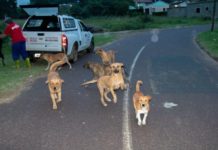This Heritage Month, South Africans are encouraged to participate in a new global celebration on Thursday, 17 September – World Manta Day. KZN South Coast-based manta ray expert, Michelle Carpenter, outlines why this is of particular significance for South Africa, which is home to the giant manta and reef manta.
Research into the manta ray
Carpenter, a PhD student at the University of Cape Town, is focusing her thesis on the use of cleaning stations by manta rays and devil rays of southern Africa (Mozambique and South Africa).
For the past four years, she has been researching these ocean creatures in Mozambique and Indonesia, and is now based at Clansthal, on the KZN South Coast, where she is studying devil rays and manta rays of the Aliwal Shoal.
Having started her research in Mozambique in 2016 with the Marine Megafauna Foundation, and then onto Indonesia in 2017, Michelle felt the need to return to Africa: “I am forever inspired by the rugged and wild beauty of the African environment, its people, and the conservation movement to fight to protect what we still have. We have the most complex, fascinating, and threatened megafauna both on land and sea.”
What is Megafauna?
This is a scientific term that signifies large animals with a complex life history, making them crucial to ecosystems. These are often the first animals to be affected by human-driven change, referred to as anthropogenic impact.
The South African significance
Although manta rays are largely understudied in South Africa, both the giant manta rays and reef manta rays are often spotted at the Wild Coast, KZN South Coast’s Aliwal Shoal, Durban and Sodwana Bay on the north coast, particularly during the annual Sardine Run.
“South Africa is a huge missing piece in the manta ray puzzle,” explained Carpenter. “No one has yet studied the manta rays here. Although we’ve found two individuals that travel to and from Mozambique and Sodwana Bay, we still have no idea if there is a unique subpopulation specific to South Africa, or one large mixing population that constantly crosses international borders. It is crucial to understand the habitat use and movements of our southern African manta rays to better protect them.”
Monitoring manta rays
Every manta ray possesses a unique spot patterning on their belly which, like a fingerprint, allows for individual identification. Over time, this photographic data provides information about population numbers, distribution, and habitat use.
“The most exciting thing about manta research is that you don’t have to be a scientist to take a photo of a manta ray belly,” said Carpenter. “Everyone can file their own pictures of mantas and join our global effort though Manta Matcher.”
What is Manta Matcher?
Manta Matcher is a public database for manta ray encounters, made by WildBook. Manta Matcher has provided global and public data, like Facebook for the world’s manta rays! Through this, citizen-science researchers have been able to discover that reef manta rays travel more than was previously known – 450 kilometres between Komodo National Park and Nusa Penida. Manta Matcher provides critical data on manta ray population estimates and movements, which is why citizens are encouraged to submit photographs of manta rays to the platform, joining the global conservation effort.
Manta ray fast facts
- Manta rays are considered one of the ‘marine big 5’.
- Manta rays are highly migratory but visit specific locations at certain times of the year, at different life stages, or in response to plankton or water current movements.
- Considered the smartest fish in the ocean, manta rays are highly social, and have specific gatherings at cleaning stations and feeding grounds.
- The manta ray is the largest ray, reaching over 8m in size (wing tip to wing tip).
- These filter feeders eat zooplankton, the smallest marine animals.
- Manta rays have two species; the reef manta ray (up to 5.5m), and the giant manta ray (up to 8+m), both found in South Africa.
- Manta rays are among the most gentle animals; they can be as playful as dolphins but are also capable of extraordinary things like diving to depths of 1400 metres.
- All species of manta and devil rays are listed as Vulnerable or Endangered on the IUCN Red-List.
Threats to manta populations
The status of manta rays is in line with that of the rhinoceros population with increasing threats diminishing the population. Intensive monitoring in Tofo, Mozambique has revealed the largest documented populations of manta rays in Africa, but also drastic sighting declines of up to 98% for the reef manta. Some of the threats to the species include:
Direct fishing for Chinese gill raker tonic – in 2018, China was granted legal fishing rights in Mozambican waters. Destructive fishing methods such as longlining, purse seine nets, gill nets, trawling, and shark nets, all of which have devastating effects on manta ray populations through bycatch.
What you can do to protect manta rays
The good news about manta ray conservation is that anyone can help from anywhere in the world. Some ideas include:
Buy sustainably-sourced seafood (use the SASSI app), or avoid eating seafood. Avoid beauty products with ‘squalene’ in the ingredients, which is sourced from sharks and rays. Avoiding single-use plastics such as plastic bags, take away items, and bottles. Use reef-safe sunscreen (zinc as the active ingredient). Reduce your carbon footprint by buying local, driving less and eating less meat.
World Manta Day
With Thursday, 17 September 2020 the inaugural celebration of this incredible creature, Carpenter urges everyone to get better acquainted with this key ecosystem addition.
“If you haven’t yet been in the water with these amazing animals, I highly recommend going out to snorkel, freedive, or scuba dive with either manta rays or devil rays. Two places I would recommend are Aliwal Shoal and Sodwana Bay.
“When you’re watching a manta ray, sometimes they will come in for a closer look, gazing into your eye, and just miss touching you by millimetres. These are some of the most magical encounters with wildlife in the world.”
She said it comes as no surprise that these animals have received attention from the international dive community: “As iconic animals, manta rays have attracted big tourist spend around the world, generating over $140 million to developing countries via ecotourism.”
With South Africa remaining a huge mystery in terms of manta ray habitat use, numbers, and travel, it is crucial to upload identification photos to Manta Matcher or email them to Michelle Carpenter at [email protected]. These will be used for research purposes only as a way to understand and better protect these animals.
To watch Michelle’s latest Manta talk free of charge, please visit
https://m.facebook.com/DiveRaid.SouthernAfrica/
And if you would like to sign up for the Bluewater University course please visit
https://www.bluewateru.com/bookings-checkout/a-day-in-the-life-of-a-shark/book












